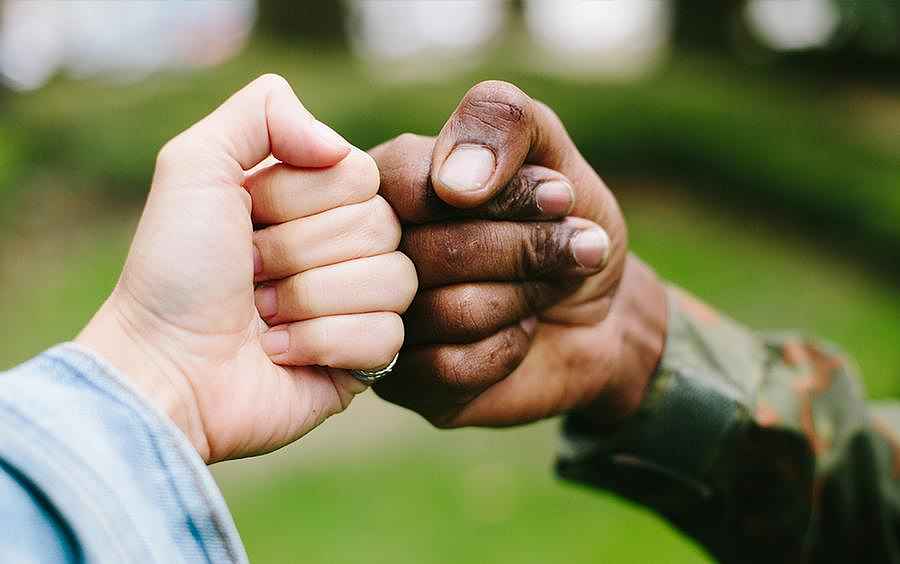





See listing of Recent and Most Popular articles on the Home Page
Connections
Category: Trends / Topics: Attitudes • Change • History • Memories • News • Racism and Inequality • Research • Social Issues • Social Movements • Trends
Race Relations by the Numbers
Posted: June 23, 2023
Childhood memories from a trip to Florida and what public opinion polling suggests about the state of race relations in America today…
My memory from riding to Florida in the back of my grandfather’s Buick was the shock of seeing unpainted houses overflowing with poorly-dressed children, their bare feet painted red with Georgia clay. Growing up white in a white neighborhood and church, I stared at the foreign landscape and people outside the car window that seemed more National Geographic than LIFE Magazine. Black men, women, and children picked cotton under the unforgiving sun while white men sat in the shade of their pickup trucks.
But most troubling were the signs. When we stopped at one of the many Stuckey’s gas stations and souvenir shops, I was shocked by the “whites only” drinking fountains. Around back was a rusty spigot labeled “colored only” next to restrooms labeled “whites only” and “colored only.” Even as a second-grader, something deep inside me wretched at the idea of “us” and “them.” Me with my Keds sneakers heading to a Florida beach; them barefoot, slaving in a cotton field. Me, drinking from a sparkling fountain; them, their mouths under a dirty faucet. I feared what lurked behind the “colored only” restroom sign.
During my childhood, blacks began to organize and protest the “separate but equal” doctrine that had bred segregation in schools, businesses, and society in general. In 1954, the Supreme Court ruled in Brown v. Board of Education that state laws establishing separate black and white schools was unconstitutional. During my grade school, civil rights leaders such as Martin Luther King Jr., Rosa Parks, and others used non-violent protest to awaken America to the plight of blacks.
Fifty years since my eye-opening trip to another world, seismic changes have rocked the landscape. More and more people of color have appeared in films and television. They have taken up roles in education, medicine, and government. And the “colored only” signs are gone.
The first black secretaries of state were appointed by George W. Bush: Colin Powell and Condoleezza Rice. Previously, Powell was a four-star general serving as chairman of the Joint Chiefs of Staff, while Rice served as special assistant to President George H.W. Bush and then national security advisor under George W. Bush.
We have now had a bi-racial president (his father, born in Kenya, is black; his mother, born in Kansas, is white.). In the Obama administration, two black attorney generals served, as well as the Environmental Protection Agency administrator, trade representative, and United Nations ambassador. In January 2009, Obama’s inauguration promised the fulfillment of America’s hope for racial equality.
But in recent years, America has added Ferguson, white privilege, and Black Lives Matter to our cultural dictionary. While the Emancipation Proclamation of 1863, the Voting Rights Act of 1965, and the Civil Rights Act of 1968 have changed people of color’s legal status, their social status has not fared as well.
Racial Relations by the Numbers
Recent polls suggest differing views from the back seat of America’s Buick and fields. In August 2014, The Washington Post polled a random national sample of 1,010 adults which included a proportional number of 639 whites and 124 blacks. It found 60 percent saying the nation needs to continue making changes to give blacks and whites equal rights, while 37 percent say those changes have already been made.
Eighty percent of blacks described discrimination as “very serious,” while only 28 percent of whites thought it so. The Post quoted a Gallup poll that showed the percentage of blacks feeling “satisfied” with the way they are treated dropped from 62 percent in 2013 to 49 percent in 2016.
A CNN poll of 1,017 adults noted a similar rise of discrimination as “very serious” from 16 percent in 2010 to 37 percent in 2015.
Racial Relations in General
A CBS News/New York Times poll released in July 2015 surveyed 1,205 adults by phone, as well as 312 blacks and 751 whites by survey. In it, 37 percent of all Americans describe race relations as generally good. The Washington Post found fewer than 40 percent believed race relations are “good.” Meanwhile, a Rasmussen Reports survey of 1,000 American adults in January 2016 found only 18 percent considered race relations to be good or excellent.
The Rasmussen polls reveals 33 percent now consider race relations poor, up from 15 percent in 2011. The CBS/NYT poll reveals both blacks and whites view race relations negatively, although more blacks (68 percent) than whites (56 percent) say they are bad. The Washington Post poll found 50 percent felt racism is a “big problem” in U.S. society, up from 33 percent in 2010.
Just 21 percent in the CBS/NYT poll believe race relations are getting better, which is statistically the same as Rasmussen’s 20 percent—a new low compared to 38 percent five years ago. And 26 percent say race relations are staying about the same.
While 38 percent in the CBS/NYT poll think race relations are getting worse, Rasmussen found higher percentages. Half (50 percent) of American adults now think race relations in this country are getting worse, up from 44 percent a year ago and up 30 percent as recently as January 2014. CBS/NYT reports both blacks and whites view race relations negatively—although more blacks than whites say they are bad. The Washington Post poll found 59 percent believing more changes are needed to give blacks and whites equal rights.
Race, age, and political party play a part in the worsening view. Rasmussen notes that those under 40 are less likely than people who are older to think relations are getting worse, but they aren’t overly optimistic. Two-thirds (66 percent) of Republicans, and 50 percent of voters not affiliated with either major party, believe race relations are getting worse. Among Democrats, just 37 percent agree, while 25 percent say they are getting better. But blacks are much more likely than whites and other minorities to believe the United States is headed in the right direction.
Even defining what constitutes discrimination doesn’t bring consensus! Rasmussen reports that 81 percent of all Americans believe the term discrimination refers to any discrimination of people of one race against another. Just 13 percent think it only refers to discrimination by white people against minorities. This is unchanged from 2013 when Rasmussen first asked this question. However, 23 percent think discrimination refers only to discrimination by white people against minorities, a view shared by just 11 percent of both whites and other minority adults.
Racial Relations and Politics
The CBS/NYT poll explored issues at the ballot box. One half (50 percent) of black Americans believe they are more likely than whites to encounter problems when voting. However, 70 percent of white Americans think blacks and whites are treated the same.
Even after two terms of having a person of color as president, Americans are more doubtful than ever that King’s dream of equal opportunity has been achieved, according to Rasmussen. Blacks are the most skeptical.
It would seem that a president who is half black and half white would bring the two sides together. However, the CBS/NYT poll suggests Obama’s presidency did not united whites and blacks. Just 15 percent of Americans say his presidency brought these groups closer together. Nearly half (47 percent), Rasmussen repots, think his presidency made no difference, while 34 percent think it has pushed whites and blacks farther apart.
CBS/NYT’s poll did report a 16 percent increase in positive opinions shortly after President Obama took office—50 percent in 2000 and 66 percent in April 2009. But by mid 2014, those positive gains had been lost in light of reported conflicts between white police officers and black subjects. At the end of 2014, only 8 percent of voters believed race relations had gotten better under Obama, according to Rusmussen. Positive opinions of the president’s effectiveness in bringing races together breaks down along racial lines, according to CBS/NYT: One-third (30 percent) of blacks and 11 percent of whites believe the president had a positive effect on race relations.
Racial Relations and Justice
CBS/NYT’s study reveals half of Americans believe the criminal justice system in the U.S. is biased against blacks, up from 35 percent two years ago. This is the highest that figure has been since the question was first asked in 1994. Again, this breaks down along racial lines with 77 percent of blacks saying American justice is biased against them. Only 6 percent of whites believe they face racial injustice.
And 41 percent of the entire electorate believes police are more likely to use lethal force against blacks. That percentage increases dramatically to 74 percent of black males and females and 83 percent of black men. While 58 percent of blacks noted that the police “make them feel safe,” 37 percent said law enforcement officers “make them nervous.” Six in ten (60 percent) of black males believe they have been stopped by police simply because they are black.
The Rusmussen survey reveals similar numbers, with 82 percent of black voters thinking blacks receive unfair treatment by police. However, the poll found that 70 percent of all voters believe the level of crime in low-income inner city communities is a bigger problem in America today than police discrimination against minorities.
For instance, The Washington Post reported that in 2015, 986 people were killed by police. Of that number, “the vast majority” were armed and half of them were white. According to FBI data, 4,906 black people murdered other blacks in 2010 and 2011. The Department of Justice reports that between 1980 and 2008, black people committed 52 percent of homicides, although they make up just 12 percent of the general population.
University of Toledo criminologist, Richard R. Johnson, crunched the numbers and discovered that “For every black man—criminal or innocent—killed by a cop, 40 black men were murdered by other black men. The biggest problem black men face is that their black lives don’t matter to other black men.”
Racial Relations in the Workplace
The PBS NewsHour and Marist College poll asked about employment opportunities. Over three-fourths (76 percent) of blacks believe they do not have the same opportunities. However 52 percent of whites believe all races have the same job opportunities. The CBS/NYT’s poll showed 60 percent of blacks believe whites have a better chance to get ahead, up from 46 percent one year earlier.
Racial Relations One on One
The CBS/NYT poll showed that 71 percent of blacks and 60 percent of whites are “uncomfortable” with discussing racial issues with another race. However, when asked if they had personally felt discriminated against, 31 percent of whites and 72 percent of black said yes. While 71 percent of Americans say there has been real progress getting rid of racial discrimination since the 1960s, that is the lowest number since 2000.
Race Relations and the Church
Unfortunately, the least-diverse groups are churches. Martin Luther King Jr. lamented that, “11 o’clock Sunday morning is still the most segregated hour of the week.”
The 2014 Religious Landscape Study looked at 29 Protestant, Catholic, and other faith groups. It noted as a baseline that the United States population is 66 percent white, 15 percent Latino, 12 percent black, and 4 percent Asian. The Seventh-Day Adventist churches are the most diverse, with 37 percent white, 32 percent black, 15 percent Latino, and 8 percent Asian.
The least diverse is the National Baptist Convention which is 99 percent black. (Martin Luther King, Jr. broke away from the convention, which had an official policy of noninvolvement with the civil rights movement.) The second least diverse is Evangelical Lutheran Church of America with 96 percent white and 2 percent black members.
Bobby E. Mills, a college professor and public sector administrator, explains the Church’s segregation as the result of “different worship styles based on distinctive cultural traditions. Experiential lifestyles and family differences cause the content of sermons and delivery styles in black and white churches to be vastly different. These facts also account for different motives for worship and church attendance.”
However, parachurch groups tend to be much more diverse. They focus on service (rescue missions, overseas development and evangelism, social services, justice advocacy, and so on) rather than worship.
One thing is clear. Polls document the fact that blacks and whites differ on the state of racial relations. When asked if racial discrimination is “very serious,” 80 percent of blacks answered yes, but only 28 percent of whites did so. Blacks and whites are closer in their views that racial relations are indeed “bad”: 68 percent of blacks and 56 percent of whites.
Change has been slow, but there has been change. On my latest trip to Florida to speak at a conference, I chose a plane over a Buick.
The woman at the check-in counter was black, as was one of the security agents. One baggage handler was Hispanic. The flight attendant was a black woman with a witty sense of humor, who playfully bantered with racially diverse passengers all harmoniously wedged into the tiny commuter plane.
Once I arrived in Atlanta, it looked like the United Nations was in town as seemingly all races and nationalities mingled in the wide concourses. Jewish yarmulkes and Islamic hijabs were sprinkled through the crowds, while the gate announcements had a distinctive Indian accent.
There were no signs segregating “coloreds” and “whites.” The drinking fountains were available for all, with even lower fountains for those in wheelchairs. The restaurants and shops welcomed all races. And on the overhead TVs, a story about black presidential candidate and former head of neurology, Ben Carson, told by a Hispanic reporter.
Great progress has been made in racial relations, but it’s clear there is still much work to do to fulfill Dr. King’s dream “that one day this nation will rise up and live out the true meaning of its creed: ‘We hold these truths to be self-evident: that all men are created equal.’” And will be treated equally.
< Jim is an author and speaker who feels privileged to have been able to minister to the multi-colored body of Christ in Africa, Asia, Australia, Europe, and North America.
Related site
Martin Luther King Jr.’s rules for protestors
If you found this helpful, please share it. Thanks!
Search all articles by James N. Watkins
Jim Watkins is a humorist, author, and speaker who says of himself that he "loves God, his family, writing, speaking and Chinese food—in that order" • Author bio (website*) • E-mail the author (moc.sniktawsemaj@mij*) • Author's website (personal or primary**)* For web-based email, you may need to copy and paste the address yourself.
** opens in a new tab or window. Close it to return here.
Posted: June 23, 2023 Accessed 417 times
![]() Go to the list of most recent Connections Articles
Go to the list of most recent Connections Articles
![]() Search Connections (You can expand the search to the entire site)
Search Connections (You can expand the search to the entire site)
![]() Go to the list of Most Recent and Most Popular Articles across the site (Home Page)
Go to the list of Most Recent and Most Popular Articles across the site (Home Page)
 Loading requested view...
Loading requested view...